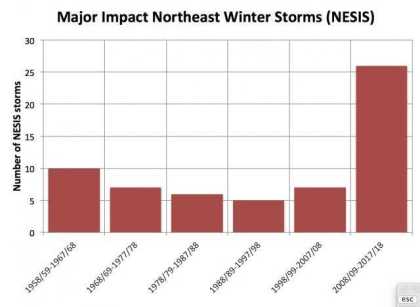I have been saying for a long time that the whole campaign demonizing carbon dioxide and seeking to limit industrial development is a political manouver and not a scientific one. Our climate is naturally variable and to think that us humans can have a significant effect is pure blind hubris. We are simply do not have that big a footprint.
Now it seems that our sun is entering a major period of coolinng off and the effects are becoming very obvious - here are a couple instances:
From NASA's Space Weather:
The Chill of Solar Minimum
The sun is entering one of the deepest Solar Minima of the Space Age. Sunspots have been absent for most of 2018, and the sun’s ultraviolet output has sharply dropped. New research shows that Earth’s upper atmosphere is responding.
“We see a cooling trend,” says Martin Mlynczak of NASA’s Langley Research Center. “High above Earth’s surface, near the edge of space, our atmosphere is losing heat energy. If current trends continue, it could soon set a Space Age record for cold.”
And, wonder of wonders, Dr. Mlynczak is talking about actual observed data and not the output of some dodgy computer model:
These results come from the SABER instrument onboard NASA’s TIMED satellite. SABER monitors infrared emissions from carbon dioxide (CO2) and nitric oxide (NO), two substances that play a key role in the energy balance of air 100 to 300 kilometers above our planet’s surface. By measuring the infrared glow of these molecules, SABER can assess the thermal state of gas at the very top of the atmosphere–a layer researchers call “the thermosphere.”
Much more at the site - this is some very well thought out and interesting science.
Next up - from Boston MA station WBZ:
Will The Snowiest Decade Continue?
Despite the snow blitz of 2015, many baby boomers still insist that, overall, we don’t get the harsh bitter cold and deep snowy winters like we did in the good ole days.
Weather records prove that just isn’t the case and despite the ongoing claims that snows are becoming rare and hurting winter sports, this millennium has been a blessing to snow lovers and winter sports enthusiasts.
Just as the Saffir-Simpson and Fujita Scales were devised to categorize hurricanes and tornadoes, the Northeast Snowfall Impact Scale (NESIS) was created by Paul Kocin and Louis Uccellini of the National Weather Service to rank high-impact Northeast storms. This scale has 5 categories including extreme, crippling, major, significant and notable. In addition to meteorological measurements, the index uses population information which provides an indication of a storm’s impacts on society. The NESIS scores are a function of the amount of snow, the area affected by the snowstorm and the number of people living in the path of the storm. The aerial distribution of snowfall and population information are combined in an equation that calculates a NESIS score which varies from around one for smaller storms to over 10 for extreme storms.
And here is the NESIS chart. Each bar represents ten years starting at 1958 to present:

Finally, it is not just cold in the Eastern USA - from David Middleton writing at Watts Up With That:
Antarctic temperatures recently plunged close to the theoretically coldest achievable on Earth!
This story was previously discussed here at WUWT… But, why wasn’t this headline news in the Washington Post, New York Times, etc.? Yes… That was a rhetorical question.
Ultralow Surface Temperatures in East Antarctica From Satellite Thermal Infrared Mapping: The Coldest Places on Earth
T. A. Scambos, G. G. Campbell, A. Pope, T. Haran, A. Muto, M. Lazzara, C. H. Reijmer, M. R. van den Broeke
First published: 25 June 2018
[…]
Plain Language Summary
The lowest measured air temperature on Earth is −89.2 °C (−129 F) on 23 July 1983, observed at Vostok Station in Antarctica (Turner et al., 2009, https://doi.org/10.1029/2009JD012104). However, satellite data collected during the Antarctic polar night during 2004–2016 reveal a broad region of the high East Antarctic Plateau above Vostok that regularly reaches snow surface temperatures of −90 °C and below. These occur in shallow topographic depressions near the highest part of the ice sheet, at 3,800 to 4,050‐m elevation. Comparisons with nearby automated weather stations suggest that air temperatures during these events are near −94 ± 4 °C or about −138 F. Ultracold conditions (below −90 °C) occur more frequently when the Antarctic polar vortex is strong. This temperature appears to be about as low as it is possible to reach, even under clear skies and very dry conditions, because heat radiating from the cold clear air is nearly equal to the heat radiating from the bitterly cold snow surface.
The paper in question can be found here: Ultralow Surface Temperatures... Dr. Middleton then goes on to cite two other papers on low temperatures in the Antarctic.
Global cooling is at our doorstep and there is little we can do about it. When I think of the billions of dollars that have been completely wasted on this - money that came out of our wallets and could have been put to better use (electricity and clean water in 3rd world villages for example) it makes me sick.

Leave a comment